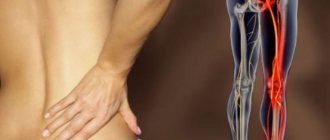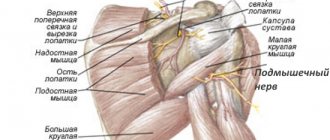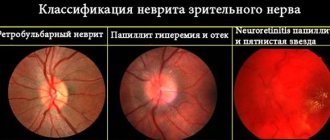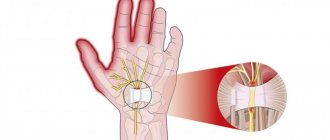What is a pinched sciatic nerve?
Pinched sciatic nerve, or sciatica, is considered quite common in pregnant women. Moreover, for some it occurs at a later stage, while for others it begins to “torment” from the very beginning of pregnancy. In addition, in approximately thirty percent of women, the pathology does not go away for a long time after childbirth.
The author of the article also encountered this. Throughout my pregnancy, starting from the first weeks, I suffered from pain in the sacral and femoral areas. More than two years have passed since the birth, and the condition has not changed. Moreover, approximately every four months the pathology worsens, significantly reducing physical activity.
Sciatica occurs due to compression of the nerve roots of the lumbosacral plexus and further compression of the sciatic nerve at the exit from the pelvic region.
A little anatomy
The sciatic nerve originates from the lumbosacral nerve plexus, located on the inner side of the sacrum. It is the largest, thickest and longest nerve in the human body.
The sciatic nerve reaches a width of 1 cm and is the largest nerve in the human body.
As you know, there are two sciatic nerves: left and right. Each of them exits the pelvic cavity through the infrapiriform foramen, formed by the sacrospinous ligament, the piriformis muscle (its lower edge) and the superior gemellus muscle, where it is covered by the gluteus maximus muscle. Next, it goes to the back of the thigh, where it gives off several branches. In the area of the popliteal fossa it divides into the peroneal and tibial nerves.
The sciatic nerve is responsible for sensation and motor function of the lower extremities. Thanks to it, a person can walk, run, jump, feel heat and cold, and so on.
The sciatic nerve along its length gives off several large branches and is responsible for the innervation of the entire lower limb
Causes of pinched sciatic nerve in pregnant women
Women who had any problems with the spine before pregnancy are primarily at risk for developing sciatica. In this case, pinching of the sciatic nerve can occur due to the following pathologies:
- Osteochondrosis of the spine, in particular the lumbosacral region. With this disease, metabolic processes in the osteochondral tissue are disrupted, which causes dystrophic changes in the vertebrae and intervertebral discs. As a result, pinching of the nerve roots of the lumbosacral nerve plexus and compression of the initial section of the sciatic nerve very often occurs.
- Intervertebral hernias. They also contribute to compression of the surrounding nerve tissue. In most cases, this process is accompanied by inflammation.
- Spondidolisthesis is a displacement of one or more lumbosacral vertebrae. This pathology causes pinching of the sciatic nerve at its exit from the lumbosacral plexus.
- Stenosis (narrowing) of the spinal canal. It is quite rare in pregnant women, but nevertheless it is a serious cause of sciatic nerve entrapment.
- Spasm of the piriformis and superior gemellus muscles, which can occur regardless of the presence or absence of any pathologies of the lumbosacral spine. An example of this could be sudden movements, incorrect or uncomfortable body position, and so on. In this case, the nerve is pinched at the level of its exit to the back of the thigh.
- Tumors of the lumbosacral spine, which also contribute to compression of the nerve roots.
- Overweight. As you know, excess body weight causes increased stress on the spinal column and often contributes to compression of the nerve roots.
- Curvature of the spine in the lumbosacral region, which causes compression of the nerve roots.
- Various spinal injuries leading to compression of nerve endings.
It is impossible not to highlight separately such a pathologically affecting factor as cold. Against the background of hypothermia, a condition called myositis very often occurs. At the same time, the skeletal muscles become inflamed, which in turn leads further to pinched nerve endings.
In addition to general reasons, there are also those that are directly related to pregnancy. These include:
- excessive amount of amniotic fluid;
- large fruit;
- the presence of two or more fetuses in the uterus;
- change in the position of the unborn child in the uterus (position of the head towards the pelvic cavity);
- divergence of the pelvic bones;
- shift of the center of gravity.
All this leads to compression of the sacrum by the growing uterus and pinching of the sciatic nerve at the site of its exit from the lumbosacral plexus.
The cause of sciatica in the author of the article was the curvature of the spine in the lumbosacral region and severe divergence of the pelvic bones. The latter was associated with a large amount of amniotic fluid and a large fetus.
Symptoms of sciatica
Symptoms of sciatica manifest themselves in different ways. This depends primarily on the level and degree of compression of the sciatic nerve. Some people get by with minor pain, while others “get it in full.”
The main symptoms of a pinched sciatic nerve are:
- pain of varying intensity, spreading from the lumbar region to the entire limb;
- sensations of numbness, burning, tingling of the skin and muscles of the lower limb along the sciatic nerve;
- impaired motor activity of the lower limb on the affected side;
- pallor or, conversely, redness of the skin on the affected limb, associated with impaired vascular functioning due to the lack of proper innervation;
- inability to indicate the exact location of pain, which in most cases covers the entire lumbar region.
As a rule, all unpleasant sensations begin in the lumbosacral region, then spread to the buttocks, back and front of the thigh, and then move to the calf muscles and foot. As a result, the woman is forced to take a certain body position, in which the pain, if it does not completely recede, then significantly reduces its intensity.
The author of the article recalls his feelings when the sciatic nerve is pinched during pregnancy. Until the end of the second trimester they were quite tolerable. The last three months were remembered for the fact that the pain was so severe that it was impossible to walk, stand, or sit. Even lying in one position for more than five minutes was unbearable. In addition, the leg often cramped, and numbness was felt in the muscles and skin.
First aid at home
If a relative or friend suddenly develops symptoms of a pinched nerve, competent first aid can significantly relieve the pain. What to do if your back suddenly gets pinched in the lower back:
- It is necessary to place the person on a flat and hard surface. This will help relieve the load on the spine; you can’t lie down on a soft sofa or bed, it’s better to lie on the floor.
- Call an ambulance or call your doctor.
- The patient can be given a painkiller such as Ketanov or Analgin, or a light sedative such as Valerian can be added.
- If a person has difficulty breathing, it is necessary to empty the chest and provide access to fresh air.
You should not try to “straighten” the vertebrae on your own or do a relaxing massage - this is fraught with dire consequences.
Treatment of pinched sciatic nerve in pregnant women
In most cases, pinched sciatic nerve in pregnant women does not require any specific treatment. As you know, most drugs and procedures are contraindicated during this period. However, there are ways to fix this problem. The only thing that needs to be said is that they will not be able to help every woman. As a rule, relief occurs only after delivery. But there are situations when the problem does not disappear even after childbirth. In this case, it is worth thinking about the presence of serious pathologies of the spine.
Self-medication of this condition is extremely contraindicated. Moreover, it can harm not only the expectant mother, but also undermine the health of the child.
The author's medical practice shows that women prefer not to pay attention to minor manifestations of sciatica, thinking that this is due to banal fatigue and overexertion. And some pregnant women experience such unbearable sensations that they ignore all doctors’ prohibitions and use various medications that are contraindicated during pregnancy to alleviate their condition, which is absolutely forbidden to do.
Pain relief medications
During pregnancy, a large number of medications used orally are strictly contraindicated. Therefore, to relieve pain caused by sciatica, doctors recommend topical medications that have an analgesic effect, are not absorbed into the blood and do not have an adverse effect on either the maternal or child’s body.
These products include ointments and creams that contain a non-steroidal anti-inflammatory component that is approved for use during pregnancy. Most often, ibuprofen-based drugs are prescribed, for example, Nurofen-gel.
The doctor may also recommend taking medications containing vitamins E and B, as well as various micro- and macroelements that promote muscle relaxation.
Massage
Many women hope to cope with sciatica associated with spinal pathologies with the help of massage of the lumbar region. It should be noted here that while carrying a baby, exposure to this area is extremely undesirable, as it contributes to the appearance of uterine hypertonicity, which in turn can put the pregnancy at risk of miscarriage (in the early stages) or provoke premature birth (in later stages).
Medical massage will be appropriate only for relaxing spasmodic thigh, calf, ankle, and gluteal muscles that have caused pinching of the sciatic nerve. This massage should only be performed by an experienced medical professional.
Self-massage at home must be approved by your doctor. At the same time, excessive pressure on the muscles is not allowed. Light massaging or rubbing of the affected area is recommended.
Physiotherapy
Most physiotherapeutic procedures during pregnancy are also contraindicated. Permitted methods include heating the affected area. Very often, doctors recommend hot salt baths, which will help relax and relieve muscle spasms that cause pinching of the sciatic nerve. In addition, the procedure will be useful for myositis. It gradually nullifies the inflammatory process in the muscle fibers, which helps to free the nerve roots and reduce pain.
It must be remembered that salt baths and all heating in general are indicated only in the first trimester of pregnancy. At later stages, doctors do not recommend resorting to this procedure, since exposure to high temperatures can provoke premature birth.
Gymnastics for pregnant women
During pregnancy, the main component of the treatment of pinched sciatic nerve is special gymnastics. It will not only keep your muscles toned, but will also help you relax them at the same time, as well as relieve pressure on the nerve endings in the lumbosacral spine. It is very important to contact a specialist so that he can advise the necessary and useful exercises in accordance with the stage of pregnancy and the cause of sciatica, and also clearly show the technique for performing them.
The therapeutic gymnastic complex consists of a number of exercises aimed at stretching the muscles of the upper lower limbs, back and pelvis. They will help not only cope with sciatica, but also prepare the expectant mother for the upcoming birth process.
A physical therapy doctor may recommend exercises for flexion and extension of the back, bending the torso to the sides, and circular rotations of the pelvis. They are allowed at any stage of pregnancy.
All exercises are performed with great care and with minimal amplitude.
Swimming will also have a beneficial effect on the spine and muscles. There are many exercises performed in the pool aimed at eliminating sciatica. But you should resort to them only after the permission of the attending physician. In addition to the positive therapeutic effect, exercise in water will help prepare the muscles of the back and pelvis for childbirth.
The use of folk remedies
Folk remedies during pregnancy are used with great caution. To avoid any negative consequences, it is imperative to obtain approval for such treatment from your doctor.
They mainly resort to methods of local influence on the affected area. Of these, rubbing with infusions of medicinal herbs is popular (products based on St. John's wort, chamomile, and linden are often used) and applications of beeswax mixed with honey. They help relieve inflammation, relax cramped muscles and release pinched nerves.
Other methods of relieving the condition of a pregnant woman
Among other things, the expectant mother is recommended to use an orthopedic mattress for sleeping, which will help to evenly distribute the load on the spine. It will also be useful to place a bolster, twisted from a blanket, or a pillow under the lumbar area.
It is worth paying attention to shoes. It should be comfortable and fit your foot size. Preferably without heels; a slight rise is acceptable, but it should not exceed three centimeters.
To relieve pain and reduce compression from the second trimester, all pregnant women are recommended to wear a special bandage. Thanks to it, the weight of the abdomen is evenly distributed over the pelvic area.
In case of exacerbation of the process, bed rest is strictly indicated. Excessive activity can lead to a sharp deterioration of the condition.
Prevention
You definitely need to make adjustments to your life, otherwise the disease will return:
- watch your posture and it is recommended to use a bandage;
- walking;
- shoes without high heels;
- sleep on a hard-covered bed.
If you follow all the necessary rules, the disease will not only recede, but will never remind you of itself.
Causes of back pain and effective exercises in the video :
Unfortunately, there is no guarantee for eliminating sciatica during pregnancy. But if a woman does not neglect special exercises, follows all the doctor’s recommendations and monitors her diet, then sciatica will be much easier to bear, since the body will always be in good shape.
The influence of sciatica on the process of delivery
As a rule, pinching of the sciatic nerve does not affect the process of delivery. A woman can easily give birth on her own. Nevertheless, there are situations when, due to severe pain, which intensifies significantly during pushing, the expectant mother is unable to push out the fetus. Then they resort to epidural anesthesia, which helps eliminate the sensitivity of the lower half of the body.
In most cases, sciatica goes away within a short period of time after childbirth.
Diagnostics
Based on a clinical examination, a preliminary conclusion can be made about a pinched nerve, but it is necessary to confirm the diagnosis using additional methods. If in normal conditions patients are recommended to undergo radiography or computed tomography, then during pregnancy such studies are strictly contraindicated, since they are accompanied by radiation exposure to the body of the expectant mother and child. Therefore, they opt for the following methods:
- Ultrasound of the spine.
- Magnetic resonance imaging.
If a pregnant woman encounters ultrasound every three months, then performing an MRI may be accompanied by certain concerns. But in most cases they are completely unfounded. Such a study is carried out only in the second and third trimester, when the magnetic field cannot harm the fetus.
Diagnosing a pinched nerve during pregnancy is not difficult. Additional studies are characterized by safety and a high degree of information content.










